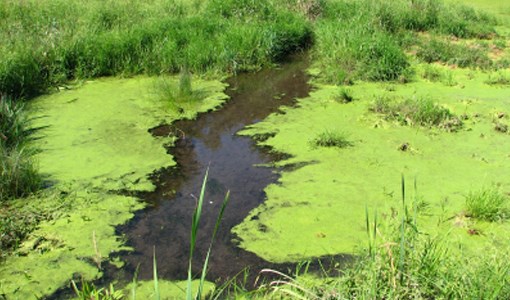Results, so far, from the 2022 blue green algae bloom in Farlain Lake were brought to a recent Tiny Township council meeting, with an explanation of findings and a request for proactive resident engagement.
Following the bloom caused by blue green algae, also known as cyanobacteria, Tiny council voted in 2022 to fund having the Severn Sound Environmental Association look into the matter.
While not a complete report due to some samples waiting to be processed, the presentation by water scientist Aisha Chiandet and algae causation study assistant Sarah Song were able to bring Tiny council up to speed with further data analysis in addition to last year’s SSEA presentation.
“The fluorometers used in our study, which were purchased with product funding from the township, measure algal pigments called chlorophyll-a and phycocyanin,” explained Song.
In measuring the two pigments, chlorophyll-a provided an approximate measure of all algae amount in water samples, while phycocyanin provided an index of the amount of blue green algae in the same water samples. The group also looked at historic water quality data, citizen science data, and data from the SSEA weather monitoring station in Lafontaine.
As a result, no blue green algae blooms were reported in 2023; however, spikes in the data did occur on July 4 and July 25, but not enough to register as a bloom.
“When looking at this data paired with the climate data,” said Song, “we noticed how the higher ratios corresponded with high water temperatures (which promote algae growth); we also noticed that higher bloom ratios followed a week or so after rain events that were greater than 25 millimetres.”
The SSEA said early- season runoff of surface nutrients, such as fertilizers, were a likely cause, as similar rainfall and warm temperatures on Aug. 12 didn’t fit the springtime pattern for potential bloom.
Water depth also contributed to potential blooms through nutrients in the bed, with greater deposits being noted along the shallow shoreline in contrast to the deeper waters further out.
“Nutrients tended to be lower in the spring where there is less shoreline activity and the concentration increases in early summer which is also around the time when increases in algae are observed," said Song.
Chiandet explained that Lake Farlain resident vigilance could play a key role in mitigating blue green algae blooms through activities like: avoiding fertilizer usage within 100 metres of the shoreline; maintaining localized deep rooted plants and shrubs to hold soil and soak up nutrients; and avoiding use of chemicals in the water, such as phosphate detergents or personal care products, that would kill helpful bacteria.
A final report by the SSEA was anticipated by Chiandet to be delivered by the end of 2023, as ice phosphorous concentrations for sediment analysis had yet to be completed.
The presentation was well-received by council. Deputy Mayor Sean Miskimins listened diligently with the proactive resident component catching his attention.
“I'm wondering if we would be remiss if we didn't include our inland lake as part of our shoreline alteration bylaw that’s coming around,” Miskimins noted. “If we are looking at our overall environments, we tend to focus on just the shoreline of Georgian Bay and sometimes forget our own inland lake as well which is an important part to a large community there.”
Public works director Tim Leitch reviewed the presentation before it was delivered to council.
“That was well spent money,” said Leitch. “It was a big concern for the lake.” He further emphasized: “The residents have a big role to play in making sure the health of that lake is maintained.”
Coun. Steffen Walma also appreciated the presentation, and asked the SSEA to provide recommendations of action for council consideration in their reports which hadn’t been present previously; Chiandet replied that the SSEA would consider the request.
During the 2022 presentation, Chiandet advised the public that due to potential health implications of pollution and spills, any suspected blooms should be reported to the provincial Spills Action Centre at 1-866-663-8477.
Individuals affected by blue green algae are strongly recommended to seek medical attention if symptoms such as skin, eye or throat irritation, allergic reactions or breathing difficulties occur following contact with the blue-green algae bloom.
Anyone who comes into contact with blue-green algae should wash with soap and water or rinse thoroughly with clean water. Swimming, bathing or showering with water not visibly affected by a blue-green algae bloom is not expected to cause health effects.
The SSEA Farlain Lake algae causation study update on blue green algae conditions can be viewed within the agenda page located on the Tiny Township website.
Archives of council meetings are available to view on Tiny Township’s YouTube channel.



